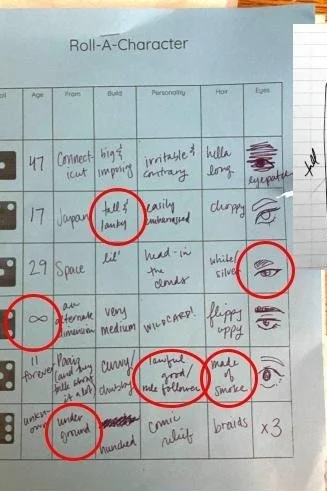Roll-a-Character
In the course I teach at my high school, Comic Books and Graphic Novels, we start with a character design as one of our very first activities. This character will be used in the first “big” (it’s only 1-2 pages, but very polished) comic we do in the course: not necessarily as a protagonist, sometimes as a villain or background character, and at times even the unfortunate victim of an inciting incident.
This lesson is a fun way to introduce the art process I use in the course (a standard thumbs, pencils, inks, color) on a singular work, through which we explore the art materials provided in the course and make something that’s usually a little goofy—a good way to get kids talking in those early days.
Having students make these boards is one of the most successful things I’ve ever done to get them to generate lots of options. Often, they get hung up on one single idea that they later regret when they start thinking more broadly: this activity gets them brainstorming widely from the very start.
I’m always clear that they can change and interpret this as desired: in the eye column, they could write colors, or draw eye shapes, or even write numbers. The build could become a species category, and the from can be as vague as “America” or as in depth as a tragic orphanage backstory.
It’s exciting to see these come together, and students like choosing their own adventure on this assignment and curating a list of options they’re personally interested in exploring.
In my own example, I tried to think outside the box in a number of the categories—seeing wacky options always gets the murmurs going as their ideas start marinating. Doing it alongside the kids last year, my combination was:
Age: Infinity
From: Underground
Build: Tall and lanky
Personality: Lawful good/rule follower
Hair: Made of smoke
Eyes: angular monolid with a short eyebrow
After their boards are complete and they roll for their features, we cover the concept of a thumbnail design. We look at examples of thumbnails for singular characters, poses, and scenes, as well as thumbnails of comic panels and entire pages. I’m careful to stress that if it looks good or fancy, they’ve done it wrong - big ideas only!
For the beginning of the year, I force students to make several different thumbnails instead of diving headfirst into idea number one. To be honest, they hate this, but some of them do end up thanking me and saying that they’re glad they tried it. I’d be lying if I said a majority of them liked this or found it useful, but I really think it’s important to give yourself the space to try things on.
In our thumbnail workshop, we generate characters and students are challenged with drawing out thumbnails of them on a sticky note. The sticky notes are organized onto a worksheet, and sorted in accordance with how successful they ended up being—with the added task of analyzing the ‘failures’ and acknowledging their importance in the process.
As a note, I’m not entirely happy with the character generator linked on the worksheet, and will be looking to replace it. It gives very detailed characters, which isn’t a problem—I tell students that we may not be able to tell from your thumbnail that your character is terrified of boats, and that’s ok—but it also has a limited number of runs per user. it reads the class, connected to the same internet, as a single user and cuts us off.
Recommendations for a solid (and school appropriate) character idea generator?
I thumbnailed live on the screen, and together we came up with a character who works as a sort of royal guard in an underground fantasy city. They’re a sort of minor villain in the story they belong to, a stickler for the rules that gets in the heroes way. Students loved collaborating on the problem solving of how this combination of traits could make sense, and we were excited about what we came up with. It started the ball rolling on students discussing their own ideas with peers and collaborating in the ideas phase, which makes such a difference.
I also pointed out to them where I cheated: I used the eye shape I rolled, but the idea of a third eye was still really interesting to me so I incorporated it anyways. I made sure they knew that being creative and making something cool was more important than obeying the whims of the die.
From this point, we begin our clean sketches and move onto workshops dedicated to inking and color that support this mini project, which I’ll cover in future posts!
For now, please feel free to access any and all materials below. Make changes, keep it as-is: anything you desire! My only request is that none of these materials be listed for sale, even with new graphics or visuals. My lessons are completely free and open to the public.
Enjoy!




